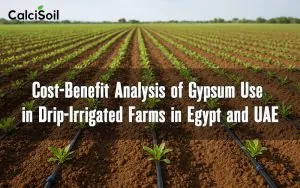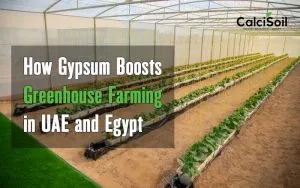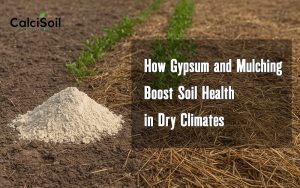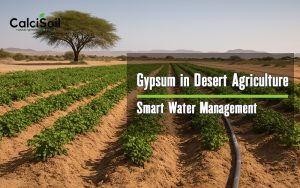
Using Agricultural Gypsum Reason
Several key factors influence farmers’ decisions to adopt using agricultural gypsum:
Improved soil quality and crop performance: Gypsum has been shown to enhance soil structure, nutrient availability, and water management – all of which can lead to improved crop yields and resilience, especially during dry conditions. These agronomic benefits incentivize farmers to adopt gypsum use.
Environmental sustainability: Gypsum can help reduce soil erosion, nutrient runoff, and the need for synthetic fertilizers, making it an environmentally-friendly soil amendment that aligns with growing sustainability concerns.
Ease of application: Farmers perceive gypsum as a relatively easy-to-apply soil amendment, which positively influences adoption.
Profit motivation: Larger gypsum-treated areas on farms are associated with a stronger profit motivation among farmers.
The use of agricultural gypsum offers several economic benefits for farmers. According to the research, farmers who have adopted gypsum use on their cropland have reported significant improvements in soil fertility, water management, and crop performance.
Specifically, the survey of farmers found that most estimated their gypsum use to be profitable, with a mean partial benefit to cost (B/C) ratio of 1.68. This indicates that for every dollar spent on gypsum, farmers saw $1.68 in benefits. The benefits from gypsum were also found to increase over time, rather than being instantaneous.
Additionally, the research suggests that substantial off-farm benefits are likely realized through gypsum use, such as improved water quality. Overall, the economic evidence indicates that the adoption of agricultural gypsum can be a profitable investment for farmers that also provides broader environmental and societal benefits.
Long-term economic benefits of using agricultural gypsum
The key long-term economic benefits of using gypsum in agriculture include:
Increased Yields and Improved Fertility Over Time
The economic returns and benefits of gypsum increase the longer it is used. Farmers who adopted gypsum prior to 2010 gave higher scores for all benefits tested compared to newer users.
Nearly 30% of longer-term gypsum users applied it to all their acreage in 2012-2013, compared to 33.8% for newer users.
Long-term gypsum users applied it to 45.7% of their cropland on average, compared to 33.8% for newer users.
Crops that benefit more from gypsum
In agriculture, there are plants that interact better and more with using agricultural gypsum, and their growth occurs at a higher rate than other plants:
Alfalfa – Gypsum is an excellent source of sulfur, which alfalfa needs in large quantities (25-50 lbs per acre) to produce a good crop. Alfalfa yields saw dramatic increases with gypsum, often achieving returns of 5:1 or higher per dollar of gypsum cost. Corn yields saw returns of 2:1 or higher.
Peanuts – Gypsum has been particularly useful for peanut farmers, as it can increase calcium content and reduce aflatoxin production in peanuts. Application rates of 600-880 lbs per acre have been used.
Corn – Corn also requires 25-50 lbs of sulfur per acre, which gypsum can provide. Studies have shown gypsum can increase corn yields by up to 25%.
Citrus – Gypsum has been shown to significantly reduce root rot caused by Phytophthora parasitica in citrus, as well as mitigate the effects of soil salinity. This makes it a valuable amendment for citrus growers.
Legumes – In general, legumes require large amounts of sulfur to form nitrogen-fixing nodules on their roots. Gypsum has been particularly useful for peanut and watermelon farmers.
Improved Soil Quality and Productivity Over Time
Gypsum improves soil tilth, water infiltration, plant rooting, seedling emergence, soil water retention, nutrient absorption, and biological activity.
The benefits of gypsum increase over time. Longer-term users rated all benefits higher than newer users.
Gypsum improves acid soils and treats aluminum toxicity, allowing for deeper root growth and better nutrient and water uptake by plants.
Higher Economic Returns Over Time
As we mentioned, on average, gypsum users received $1.68 in return for every dollar invested, with longer-term users experiencing even higher returns.
The mean benefit/cost ratio was higher for long-term (1.76) versus short-term (1.63) users, although not statistically significant.
Fewer long-term users reported a benefit/cost less than 1.0, and more reported ratios of 3.0 or greater.
In summary, the long-term economic benefits of gypsum increase the more it is used, with higher yields, improved soil quality and fertility, and greater returns on investment. The benefits compound over time as gypsum improves soil health and productivity.







